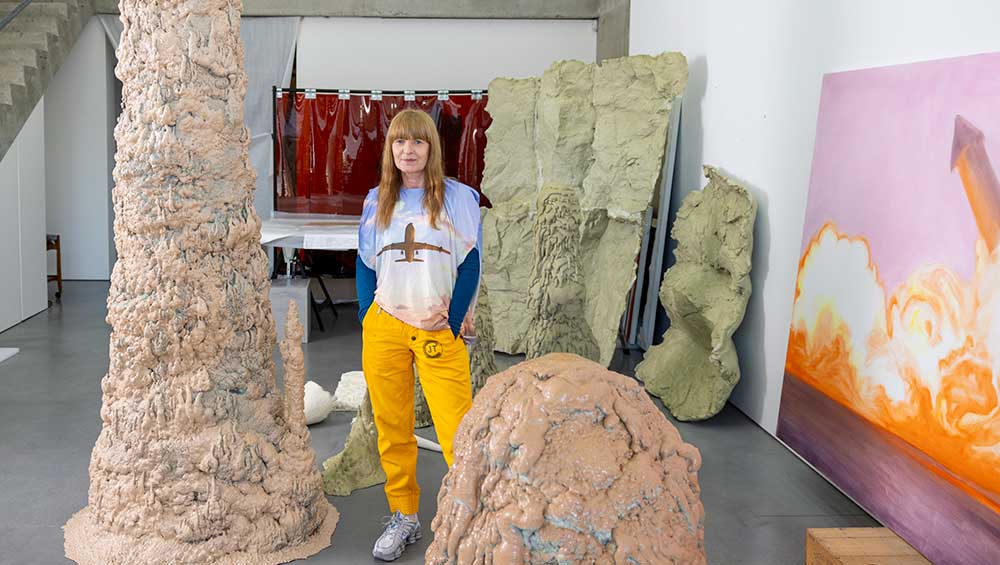
Goshka Macuga, Born from Stone, 2024. Photo: Jason Alden.
by ANGERIA RIGAMONTI di CUTÒ
Goshka Macuga (b1967, Warsaw) has variously been described as an artist, researcher and curator, while emphatically resisting such distinctions. Interested in the relationships between objects and their historic and archival contexts, her works assume the form of sculptural environments, tapestries, collages and politically inflected installations, according to her expressive and conceptual requirements.
Here at Bloomberg Space, in the ground-floor entrance that hosts exhibitions relating to the subterranean Mithraeum, Macuga has fashioned a series of intricately sculpted, viscously magmatic rock formations in dialogue with the crypt-like temple below. Also part of her curated environment are works from the Imperial War Museum collection representing scenes of second world war devastation, thus connecting the gory, if probably only symbolic, iconography of the Mithraic tauroctony (Mithras slaying the bull) to humanity’s never-ending history of violence. Or, to recall Walter Benjamin’s ever apposite observation: “There is no document of civilisation which is not at the same time a document of barbarism” (1940).
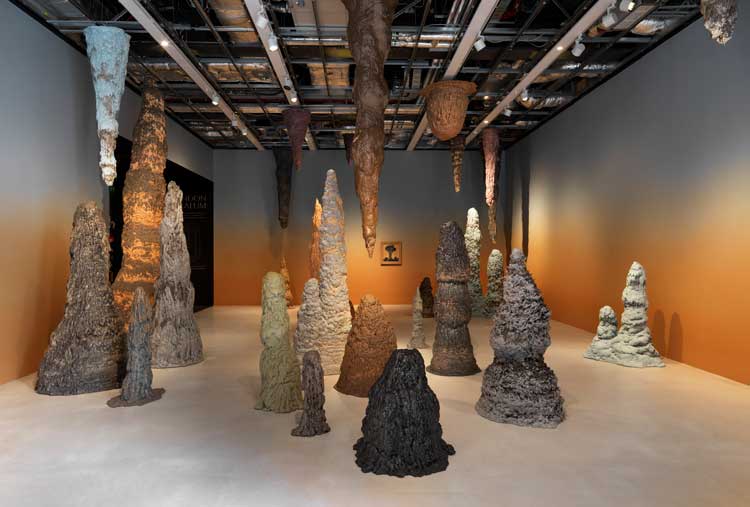
Goshka Macuga: Born from Stone. installation view, London Mithraeum Bloomberg SPACE, © Marcus Leith.
Regrettably, the strangely ill-conceived design of the ground-floor atrium displaying contemporary installations is fatal to even an intimation of an auratic experience, in contrast with the plausibly atmospheric Mithraeum down below. Viewers enter the exhibition space directly from the street and are assailed with the humdrum commotion of ticketing and timeslot checks, almost within touching distance of the works, exacerbated during this visit by the additional presence of various tables for activities, further hindering a minimally immediate, let alone enveloping, viewing and experience of these striking works.
Macuga responded in writing to Studio International questions.
Angeria Rigamonti di Cutò: When you were invited to produce this exhibition, did you know the London Mithraeum? What were your thoughts about this interpreted reconstruction of an ancient site where many gaps, in every sense, had to be filled in?
Goshka Macuga: I first encountered the London Mithraeum several years ago when I attended an opening event there. It was during this visit that I discovered the reconstructed temple beneath the site. The history of the Mithras cult, which originated between the first and fourth centuries AD and was brought to Britain by the Romans after their invasion in AD43, deeply intrigued me. The Romans established their settlement, “Londinium”, on the Thames, within what is now the City of London. The original Temple of Mithras, built by the Romans, was unearthed in the 1950s, and the entire site was eventually relocated before its current reconstruction beneath the Bloomberg headquarters.
The reconstruction of such an ancient site, especially one with so many historical gaps and ambiguities, presents challenges and opportunities. I found myself captivated by the narratives attached to the temple – stories that blend history, mythology and ritual. However, I was also struck by the enigmatic nature of the Mithras cult itself. It was a secretive and male-dominated religion, with rituals and symbols often centred around violence and sacrifice.
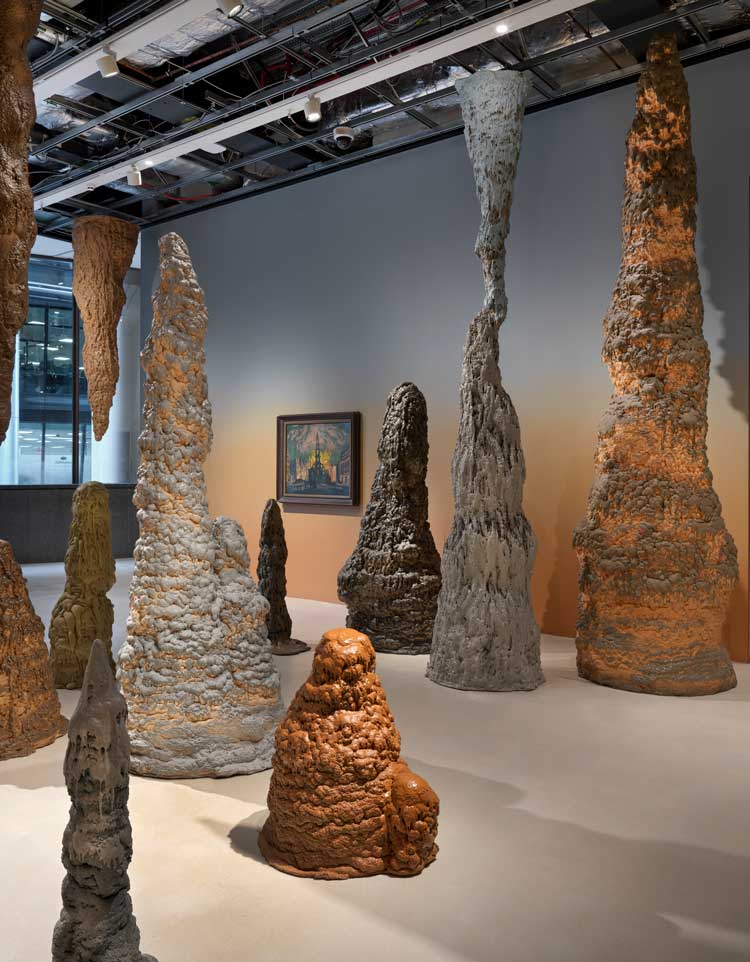
Goshka Macuga: Born from Stone. installation view, London Mithraeum Bloomberg SPACE, © Marcus Leith.
ARC: There are various layers, of structure and meaning, in the palimpsest-like construction of the London Mithraeum: the contemporary space at ground level where your installation is displayed, the lower mezzanine and, still further down, the temple and the River Walbrook, now channelled into a sewer. All these strata have, in turn, been subsumed within the Bloomberg HQ, a monument to capitalism. It would seem difficult, for both viewer and artist, to ignore the overall effects of this location?
GM: Given the deeply layered context of the London Mithraeum, I decided to engage with the site’s specificity in a suggestive way. I wanted to create a layered exhibition that addresses the complexities you mentioned, while also incorporating references to current global political issues. These references are presented in a symbolic manner, encouraging the viewer to make their own connections rather than offering explicit interpretations.
The imagery associated with Mithras – such as his birth from a rock, the slaying of the bull, and his banquet with the sun god, Sol – offers rich allegorical material. Interestingly, the “bull” also represents the growth of the stock market, and the act of sacrificing the bull could be seen as a counterpoint to the optimism and confidence typically associated with financial markets. This juxtaposition offers one possible interpretation, not just within my exhibition but in the broader context of the Mithraeum and its connection to the Bloomberg building.
Some depictions of Mithras show him emerging from a rock as a youth, wielding a dagger in one hand and a torch in the other, or sometimes holding a globe and accompanied by a thunderbolt. Flames often shoot from the rock and his cap, creating a powerful image that emphasises sacrifice and the violence involved in it. This visual representation of Mithras slaying the bull can also serve as a poignant analogy for humanity’s destructive impact on the environment, though it’s open to interpretation based on the viewer’s imagination.
The paintings I’ve proposed for the exhibition capture scenes of fires and explosions tied to historical wars, but they also connect to contemporary conflicts we see in the news every day. By layering these images with the ancient symbolism of Mithras, I wanted to create a space where the past and present resonate with each other, offering multiple layers of meaning for the viewer to explore.
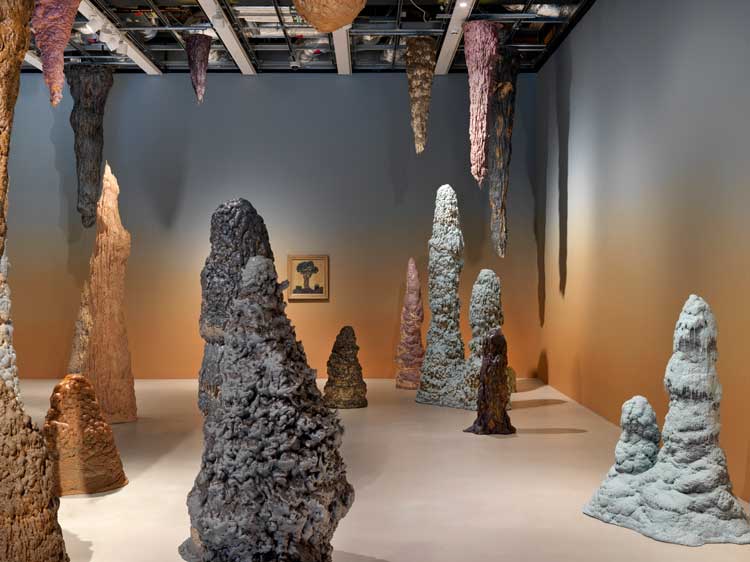
Goshka Macuga: Born from Stone. installation view, London Mithraeum Bloomberg SPACE, © Marcus Leith.
ARC: An integral part of your work consists of archival and other research. There aren’t many primary sources that say much about Mithraism, and, at the same time, as Mary Beard has quipped, facile misconceptions about the religion abound, such as the notion that it was a secret cult.1 How did you approach your research in this case when there is almost no archive?
GM: In approaching research on Mithraism, particularly when faced with the scarcity of primary sources and the prevalence of misconceptions, I had to be strategic and resourceful. Given the limited archival material and the closure of the Museum of London for relocation – where many key archaeological findings related to the Mithraeum are housed – I had to rely on the available knowledge.
My research was grounded in synthesising available archaeological evidence and secondary literature. This included examining academic articles and studying the artefacts housed in the Mithraeum within the Bloomberg Space. The violent and mysterious imagery often associated with Mithraic practices was crucial to my approach. I explored these findings – physical artifacts and textual evidence – within the broader context of religious practices across human history and the evolution of cultural landscapes from prehistoric times to the present. This allowed me to frame Mithraism not just as an isolated phenomenon but as part of a continuum in our political, social and cultural development.
ARC: This is also far from being the first time you’ve curated your own exhibition. How does your relationship to making the work change when you’re orchestrating the whole installation, albeit within the constraints of a particular site? Are there potential disadvantages to the artist taking on roles that extend beyond the work’s material production, or do you not see those roles as discrete?
GM: My artistic practice has often been described as encompassing the roles of artist, curator, collector, researcher and exhibition designer. Rather than viewing these categories as separate or discrete, I see them as interconnected aspects of my practice that collectively define my position within the broader art historical taxonomy. My work spans a variety of media, including sculpture, installation, photography, architecture, design, performance and video. Through this multidisciplinary approach, I aim to create my own systems for generating and preserving knowledge.
While I don’t consciously project myself into the categories often attached to my practice, I understand the necessity of such categorisation in structuring and systematising the gathering of historical material. However, I believe that artistic methods are highly individual, and not all artists feel the need to define their position.
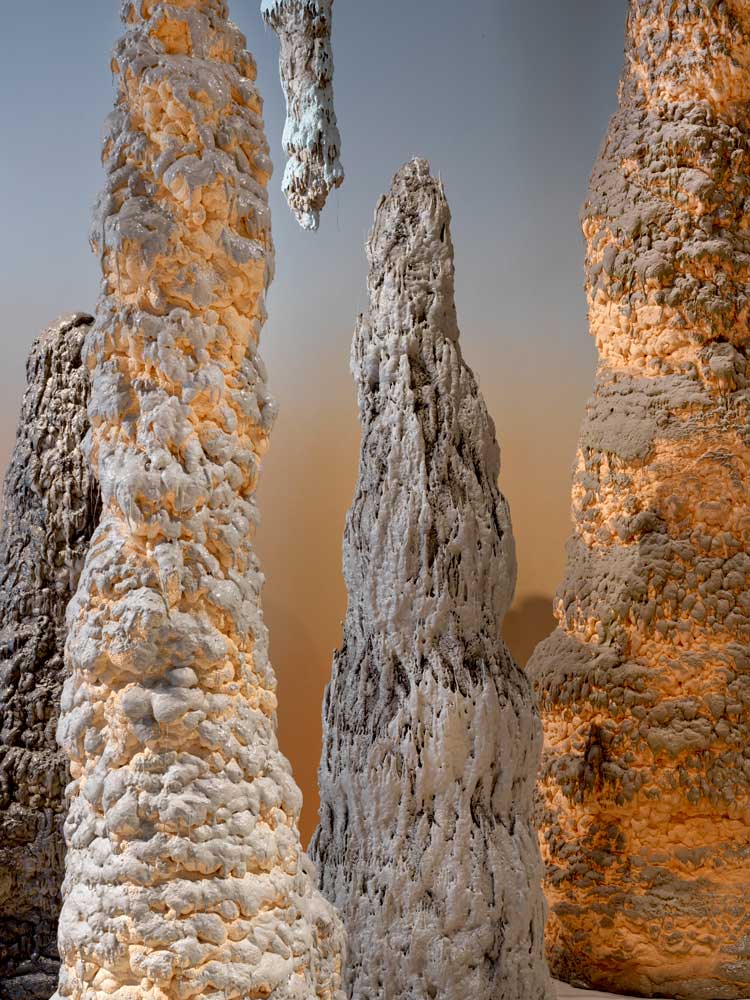
Goshka Macuga: Born from Stone. installation view, London Mithraeum Bloomberg SPACE, © Marcus Leith.
Whether I’m creating a single work or orchestrating an entire installation, my approach remains consistent in terms of preparation and concept development. The difference lies in the complexity of layers that emerge in an installation, which naturally becomes more elaborate compared to a singular piece. My aspiration has always been to cultivate an artistic practice that resists being easily defined or confined to a single activity.
I don’t romanticise studio-based process art, but I do value the time I spend working alone in my studio. Since my work occupies much of my life, I strive to keep it diverse and open to change, ensuring that it continues to evolve and stimulate me.
ARC: The environment you’ve created here is fundamentally a cave, and you’ve previously used the idea of rock-like structures, in your first solo exhibition and, most recently, in the group show Hollow Earth: Art Caves & The Subterranean Imaginary (2022-23). Other than the subterranean link to Mithraea, what is it about these underground spaces that is compelling?
GM: The cave or rock feature is a recurring motif in various interpretations of the mythological narrative associated with Mithras, often symbolising a place of origin or creation. In the context of Mithraism, the cave represents the sacred space where Mithras was born, embodying a literal and metaphorical beginning. However, the allure of caves and underground spaces extends far beyond this specific myth. Caves have long held a profound significance in human history and imagination, symbolising the origin of human creation itself. From the prehistoric cave paintings of Lascaux, where early humans first expressed their connection to the world through art, to futuristic visions of caves as shelters in post-apocalyptic scenarios, these spaces have been central to our understanding of existence and survival.
The philosophical resonance of caves is also significant. Plato’s Allegory of the Cave, for instance, is a foundational metaphor in western philosophy, illustrating the journey from ignorance to knowledge. In this analogy, the cave represents the limited perspective of those who are unaware of the broader reality, while the process of emerging from the cave symbolises the enlightenment that comes with philosophical inquiry. This allegory not only reflects Plato’s thoughts on the nature and limits of human knowledge but also serves as a broader contemplation on the true nature of reality and the human condition.
In my own artistic practice, the cave has been a recurring theme that I have explored in various forms. My first significant exploration of this concept was an installation made from crumpled brown paper in 1999, resembling a cave, for an artist-run space in London called Sali Gia.
In Hollow Earth: Art Caves & The Subterranean Imaginary, I was invited to recreate a version of the 1999 “Cave” as a representation of a moment in time that was characteristic of London’s artist-run spaces in the late 90s. These spaces were vital to the development of many artists, including myself, as they provided a ground for experimentation and the evolution of new approaches not restricted by institutional or commercial context. Recreating the cave for this exhibition was not just about revisiting a past work but also about acknowledging the formative influence of those early artistic environments on my practice.
What compels me about underground spaces is their ability to encapsulate physical and metaphysical dimensions. They are spaces of concealment and revelation, darkness and light, safety and danger. Caves offer a unique environment where the boundaries between the inner and outer worlds blur, allowing for a deeper exploration of themes related to creation, transformation and the human experience. These spaces, whether literal or metaphorical, continue to inspire my work as they resonate with the timeless human quest for understanding and the complex interplay between the seen and unseen aspects of our existence.
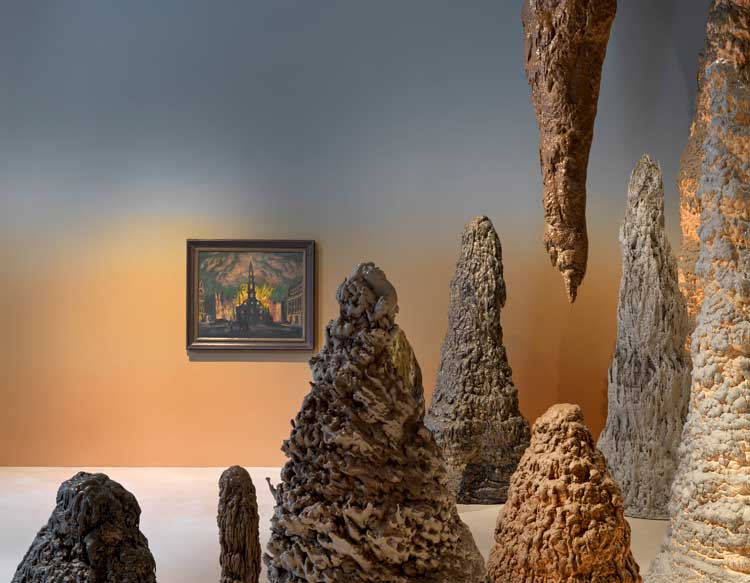
Goshka Macuga: Born from Stone. installation view, London Mithraeum Bloomberg SPACE, © Marcus Leith.
ARC: In addition to the rocky forms you’ve made for the installation, you also selected three paintings from the Imperial War Museum’s collection to display in the exhibition space: Alfred Thomson’s A High Explosive Bomb in High Street, Kensington, 18th February 1944 (1944); Henry Carr’s St Clement Dane’s Church on Fire After Being Bombed (1941) and Priscilla Thornycroft’s Runaway Horse in an Air-raid Alarm, London, Autumn 1939 (1955). What was your intent in choosing works graphically portraying wartime London and its destruction, and how did you want to relate this to the context of the Mithraeum? Was it partly a case of the geographic proximity of those scenes to the temple’s site? I also assumed the impaled horse in Thornycroft’s picture recalled the Mithraic tauroctony.
GM: The selection of these particular paintings was driven by more than just their geographic proximity to the Mithraeum. They graphically portray the destruction of wartime London, which creates a powerful resonance with the themes of violence and sacrifice inherent in the Mithraic tauroctony. The image of the impaled horse in Thornycroft’s painting, for instance, naturally recalls the ritualistic sacrifice of the bull in Mithraic iconography, drawing a direct parallel between the ancient and the modern in terms of human suffering and the cyclical nature of violence.
Beyond these symbolic connections, my intent was also to address the contemporary relevance of such imagery. The works chosen from the Imperial War Museum’s collection are not just historical records; they are reminders of the destruction that has repeatedly occurred in close proximity to this site and, more broadly, in our own time (the attacks of 7/7 for instance). By incorporating these paintings into the exhibition, I wanted to evoke a sense of the ongoing proximity of conflict and destruction in today’s world, suggesting that the traumas of war are never as distant as we might wish to believe.
My interest in this approach is deeply influenced by my early education in Poland, where the legacy of oppression, censorship and the struggle for freedom during the partitions of the Polish-Lithuanian Commonwealth left a lasting impact. During that period, Polish poets, writers and artists developed a covert language – often referred to as Aesopian language – to circumvent censorship. This hidden mode of communication allowed them to embed subversive messages within their works, a strategy that has continued to resonate with me. The historical time shift was one of the methods used.
In recent years, I’ve revisited these methods, applying them to the way I orchestrate exhibitions. By borrowing these paintings from the second world war, I aimed to draw a parallel between the conflicts of the past and the ongoing conflicts of today, emphasising how history’s echoes are still very much present in our surroundings. Through this subtle, coded approach, I wanted to invite viewers to consider the thin veil that separates past horrors from current realities and the ways in which such events could unfold around us once again.
ARC: You’ve worked with such diverse media that it’s hardly possible to associate your work with any one in particular: tapestry, collage, photographic textiles, etc. Here, you were working with sculpted resin and seem especially interested in focusing on the intrinsically formal properties of the intricately fashioned sculptures?
GM: My method of working has evolved significantly over the years. From my early, more “curatorial” projects to my recent works, I’ve consistently sought to understand and question how the context, whether a museum or an institution, impacts both the content and display of my work. This curiosity has led me to engage deeply with the archives of various institutions, as well as the stories and narratives they hold. By weaving together information from disparate sources, I aim to create a subjective interpretation of events.
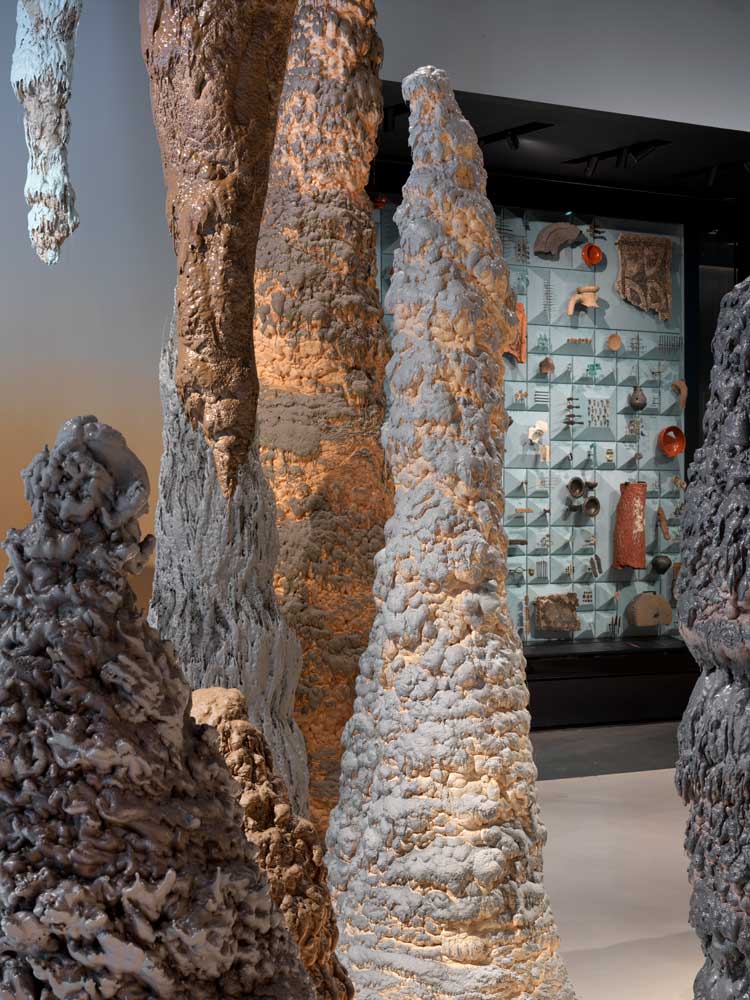
Goshka Macuga: Born from Stone. installation view, London Mithraeum Bloomberg SPACE, © Marcus Leith.
I don’t have a strong, romantic attachment to any particular medium. Instead, I tend to work with a specific medium for a period of time, exploring its potential before moving on to something new. However, this doesn’t mean I abandon previous mediums entirely – I often work with multiple mediums simultaneously.
Since the Covid-19 pandemic, my focus on making work in my studio has intensified. The sculptures I produced for the Born from Stone exhibition resulted from a year-long process of research and experimentation with materials. The layering of the wall paintings, the sculptures, and the borrowed works from the Imperial War Museum came together in a simple yet potent formula comprised of three key elements.
In this exhibition, my focus was on creating a cohesive environment where the materiality of the sculptures could interact well with the nature of the space and the historical context provided by Temple of Mithras as well as the borrowed works from the Imperial War Museum. The resin sculptures, with their intricate forms and textures, allowed me to delve deeply into the formal aspects of sculpture, exploring how these elements could contribute to the overall narrative and spatial dynamics of the exhibition. This approach, while rooted in a specific medium, ultimately reflects my broader practice of using the most fitting tools and materials to convey the ideas and stories that drive my projects at particular time.
ARC: You moved to London from Warsaw at an epochal moment, 1989 [the fall of communism in Poland]. What has been the evolution of your relationship with your country? Poland has seen such a dramatic zigzag of power between contrasting poles of the political spectrum.
GM: When I left Poland in 1989 to move to the UK, I found myself grappling with a sense of displacement. As a young woman, I had to navigate the challenges of finding a place of belonging in a new country while simultaneously developing a methodology for my work as an artist. My education was divided between Poland, where I studied fine and applied arts during the communist regime, and the UK, where I completed my BA and later my master’s in fine art in the early 1990s.
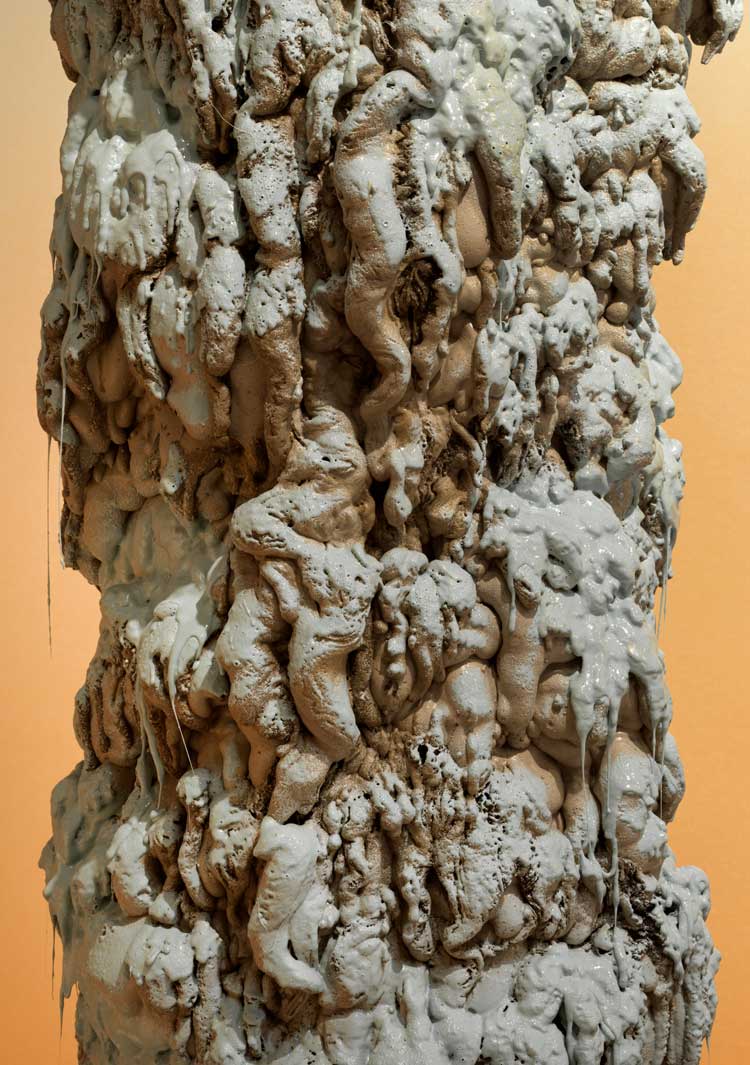
Goshka Macuga: Born from Stone. installation view, London Mithraeum Bloomberg SPACE, © Marcus Leith.
The theme that has consistently emerged in my work is the problematic in representation of truth. The gaps in Poland’s historical narrative, which continue to surface even today, have led me to question the value of my early education. This questioning has, in turn, motivated me to incorporate a research-based approach into my artistic practice, allowing me to learn and decode the environments in which I find myself. While my education in Poland was shaped by the constraints of the eastern European context up until 1989, it also provided me with unique insights and tools to critically filter the information I encounter. This scrutiny of historical narratives is something shared by many who were educated under that system.
Since 1989, technological advancements have undoubtedly expanded our ability to search for answers and uncover facts, compared to the analogue, state-controlled means available during my childhood. However, even today, the sources of information we rely on are not always reliable. This has become particularly evident under the rule of the Law and Justice Party (PiS), which governed Poland until recently. During its tenure, the PiS systematically sought to limit the personal freedoms of citizens, undermining the independence of the judiciary, restricting media freedom, and curbing the rights of women and LGBTQ+ individuals.
The PiS government’s efforts to control the flow of information and impose a narrow, nationalistic narrative have had a profound impact on Polish society. In response, many artists, writers and activists have turned to alternative means of expression, documenting the realities of life under a government that often prioritises ideological/religious conformity over individual rights. These independent projects have become vital in preserving a more nuanced and truthful record of current events, challenging the official narratives promoted by the state.
In Poland today, artists and creators are focusing their attention on a range of critical issues, including the restoration of civil rights at the rise of intolerance, and the ongoing humanitarian crisis resulting from the war in Ukraine and the migration across the Belarusian border. Additionally, the ecological crisis is influencing not only the means of production but also the nature of the work and knowledge being created.
My relationship with Poland remains complex, shaped by my early experiences and the evolving political landscape. While I live and work in the UK, the questions and concerns that arise from my Polish heritage continue to inform and enrich my practice, driving me to explore the multifaceted nature of truth in both personal and broader historical contexts.
Reference
1. Mary Beard, posted on X, September 2014. “Nice to see London Mithras temple in news. Get ready for misinformation: Mithraism NOT secret cult (met in hidden temples, that’s different!). No disguising membership. Public dedications. Plenty written in antiquity about the theology involved. ‘Cult’ also misleading.”
• Goshka Macuga: Born from Stone is at London London Mithraeum Bloomberg Space until 18 January 2025.
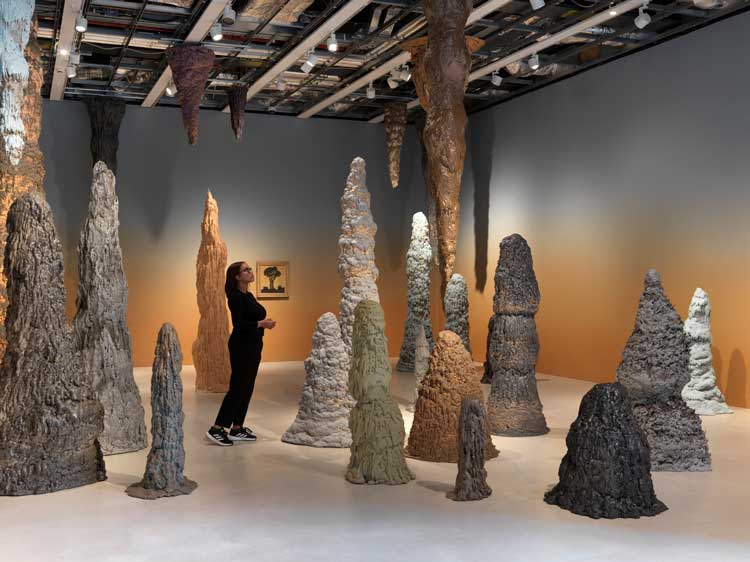
Goshka Macuga: Born from Stone. installation view, London Mithraeum Bloomberg SPACE, © Marcus Leith.
Click on the pictures below to enlarge